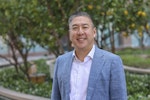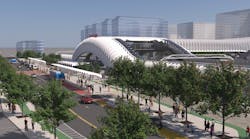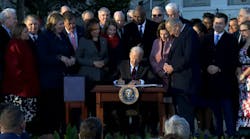Transportation industry must step up to solve engineering talent shortage
The transportation industry is at a pivotal moment. With unprecedented investment in infrastructure through the passage of key legislation, including 2021’s Infrastructure Investment and Jobs Act, coupled with diversity, equity and inclusion initiatives like the Equity in Infrastructure Project and the federal government’s Justice 40 requirements, there is a growing need for an expanded engineering workforce that is diverse, well-rounded and understands the interconnections between transportation modes and their impact on community access, connectivity and equity.
However, with the substantial investment in transportation infrastructure and the state of good repair, commitment to increasing diversity of the workforce and the rapid retirement of longstanding experts, the industry also faces a roadblock: A significant talent shortage in the face of rising project requests. The transportation industry workforce must be adaptable and knowledgeable across various sectors. It’s up to the industry to focus on attracting and developing versatile engineers able to navigate the complexities of modern infrastructure needs, ensuring the successful transition to a multi-modal mobility system that supports complete, accessible and equitable communities.
The current challenges in the transportation engineering workforce
The need for engineers in the transportation sector is intensifying as demand across the U.S. climbs for infrastructure projects that integrate equitable, sustainable and resilient solutions to enhance public transportation systems. According to industry analyses, the U.S. faces a shortage of nearly 200,000 engineers annually. This issue is exacerbated by an aging workforce and intense competition from other sectors equally in need of technical skillsets, creating a substantial gap between the available workforce and the needs of both ongoing and future projects.
Furthermore, the development of a well-rounded engineer is often stunted by specialization traps when new engineers quickly become siloed into specific sectors based on initial project assignments, limiting exposure to diverse experiences and often restricting career growth. This over-specialization often also leads to disenchantment among engineers seeking broader exposure and opportunities, resulting in retention issues, a lack of skill versatility and challenges to match talent with demand across different sectors. Ultimately, these inefficiencies can lead to project delays and increased costs while also impeding the workforce's ability to innovate and meet the evolving demands of modern, sustainable infrastructure development.
Addressing industry needs
To address the challenge created by the industry’s pressing talent gaps, strategic initiatives to attract, develop and retain talent are essential. Accomplishing this involves creating pathways for continuing education and professional development, essential for keeping up with rapid technological advancements and evolving environmental and social challenges.
Preparing for future challenges also means equipping engineers with the skills necessary to adapt to innovations such as automation and smart transportation systems while fostering expertise in sustainable practices and innovative project delivery models, such as design-build projects. Current projects, such as AECOM’s work on the California High-Speed Rail, the Portal (also known as the Downtown Rail Extension) Project in San Francisco and the Los Angeles County Metropolitan Transportation Authority’s East San Fernando Valley Light Rail Transit Project exemplify the need for cross-sectional knowledge and coordination. An engineer must be equipped with a broad range of expertise varying from urban transit and high-speed rail to community impact assessment and roadway design. Multi-faceted expertise is not simply desired, but required across current infrastructure projects.
The solution: Rotational on-the-job programs
Rotational on-the-job programs bridge this critical talent gap. Programs that provide early career professionals with a comprehensive understanding of various industry sectors by rotating participants through multiple divisions allow engineers to gain a diverse set of experiences and skills. This experience is crucial for addressing the multifaceted challenges of the modern transportation industry.
For example, AECOM’s Transportation Rotation Program (TRP) is an 18-month program that offers participants the opportunity to gain hands-on, real-world experience across three divisions of their choice, including transit/rail, surface transportation, structures, aviation, ports and marine, traffic/intelligent transportation solutions and construction management. The program is open to graduating civil engineers interested in transportation and those who wish to apply can do so via AECOM’s website on the Careers page. Applications for the next cohort will open in spring 2025.
This unique, on-the-job approach equips engineers to bring expertise to every facet of a development like AECOM’s involvement with the Los Angeles International Airport expansion. This project included not only expansion of the main terminal, but also relocation of runways and intermodal transportation systems. Additionally, the rotation program empowers participants by allowing them to select divisions of interest, fostering autonomy and aiding retention. By engaging in diverse planning, engineering and construction assignments on actual projects, participants gain practical, real-world exposure to a wide range of transportation modes and project phases – crucial in developing well-rounded professionals capable of addressing the industry’s multifaceted challenges and building strong leaders through direct, hands-on experience. Upon completion of the program, graduates have the opportunity to choose a division within AECOM where they wish to continue their career, allowing them to leverage their newfound expertise across multiple sectors.
The broader impact on the industry
Beyond serving as a career development tool, rotational education programs like TRP can represent a strategic initiative that reflects companies’ commitments to innovation, sustainability and community impact. By offering a dynamic and fulfilling career path, rotational education programs strengthen a company’s competitive edge in attracting and retaining top engineering talent. These programs also provide engineers with diverse experiences across multiple sectors, allowing them to develop a comprehensive skill set and deeper understanding of the industry, preparing them for future challenges.
For other companies considering similar initiatives, implementing a rotational program can be a strategic way to address workforce challenges. By providing employees with unique opportunities to explore different areas of the company, organizations can uncover hidden talents, improve cross-functional collaboration and drive innovation while building employee retention and satisfaction. This not only bridges the gap – it creates the possibility for the industry to expand into new areas with multi-disciplinary experts.
By offering dynamic and fulfilling career paths, a business can not only attract top engineering talent, but can also retain it by providing diverse experiences across multiple sectors; creating and supporting engineers well-equipped to meet the industry’s ever-evolving needs – and creating an environment where people come to grow and stay to thrive.

Andrew Liu | Senior Vice President and Regional Business Line Leader for U.S. West Transportation at AECOM
Andrew Liu is the senior vice president and regional business line leader for U.S. West Transportation at AECOM. In this role, he oversees all business operations for Aviation and Ports & Marine for 33 states in the western United States and Transit-Rail, Highways & Bridges, Intelligent Transportation Systems and PMCM for the west coast. Liu is based out of AECOM’s downtown Los Angeles, Calif., office.
Liu is a civil engineer by background, with approximately 25 years of experience in design, construction and project management of transportation infrastructure, including transit systems, highways, bridges, airports and ports. Prior to his current role, he has also held multiple senior transportation leadership roles at AECOM and other companies.
Outside of AECOM, Liu serves on multiple external organizations, including on the current board of California Transportation Foundation and Smart City Works Venture Studio and previously as the chair of the ITS Americas Emerging Technologies committee, Board of the LA Chapter of ASCE Geo-Institute and Aspire ERC.
Liu is a licensed civil and geotechnical engineer in the state of California and received his bachelor’s and master’s degrees in civil engineering from UCLA with honors and his MBA from the Wharton School.

Neha Yadav | Senior Project Manager for Transit & Rail Division, West Coast Region at AECOM
Neha Yadav is a senior project manager for Transit & Rail Division, West Coast Region at AECOM. Yadav has over 17 years of experience in urban, streetscape and land development design and project management.
Yadav is based in AECOM’s downtown Los Angeles, Calif., office and serves as deputy project manager on transformative projects in the region such as Vermont Transit Corridor and Los Angeles County Metropolitan Transportation Authority's Regional Rail On-Call. She is passionate about public benefit infrastructure projects and enjoys working with communities to create safe, accessible, equitable and healthy spaces as a connecting fabric in socio-economic diverse societies such as Los Angeles.
Yadav also demonstrates a commitment to the community by way of mentoring young professionals, having initiated Industry Shadow Programs in collaboration with ASCE and ITE student chapters at UCLA. She is a licensed civil engineer in California, with a master’s degree in civil engineering from UCLA.
Prior to joining AECOM, Yadav was a principal at a medium business firm leading practice building in public works and infrastructure market.






